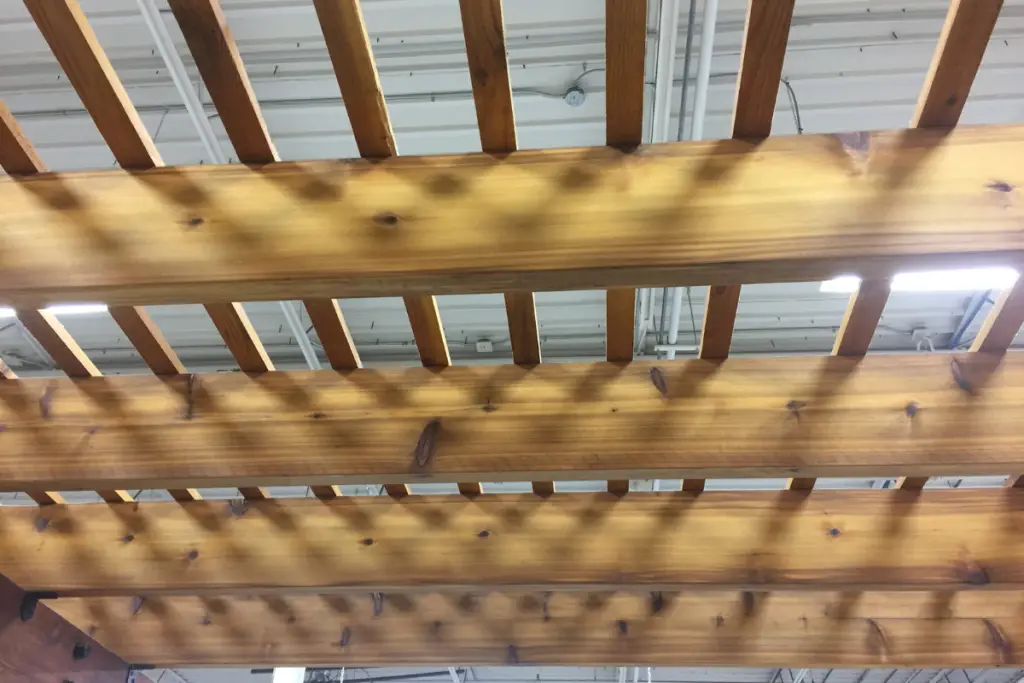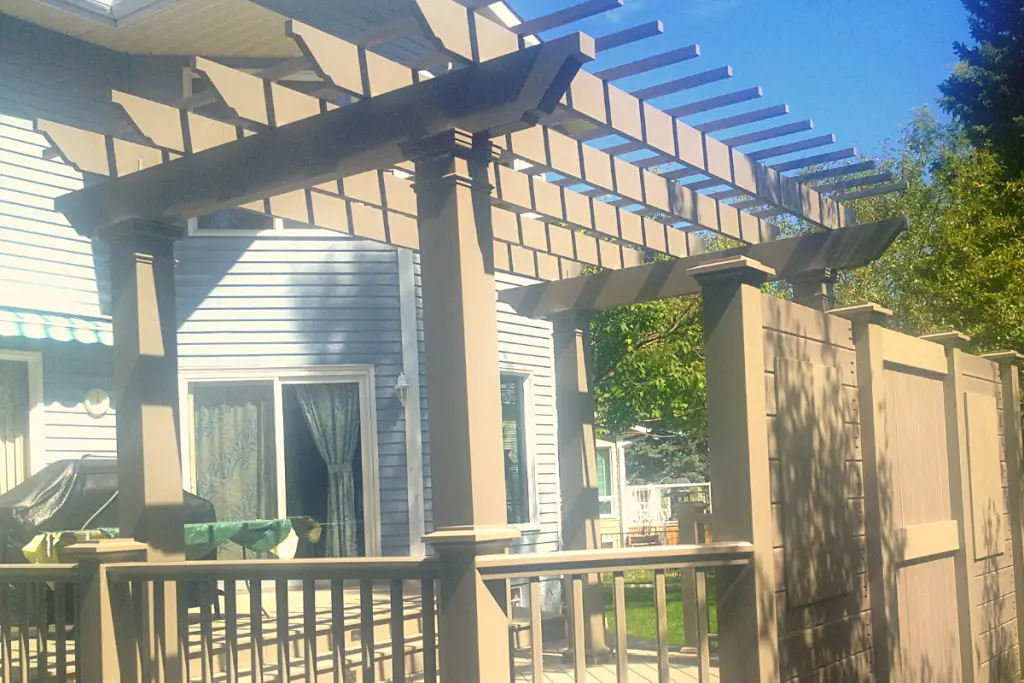A pergola is a great addition to any deck or patio, offering a variety of benefits that can make your outdoor space more inviting and attractive.
Including a pergola on your deck or patio will help maximize your outdoor space’s potential, by making your deck or patio more comfortable under the blazing sun. A pergola adds aesthetic value to your yard by adding depth to otherwise mundane area.
But we are just getting started with reasons to include a pergola in your deck or patio design.
There are many benefits of having a pergola over your outdoor space.
Below are nine of the most compelling reasons why you should consider including one on your deck or patio.
But before the reasons for a pergola. Let’s make sure we are both talking about the same thing.
What is a Pergola?
A pergola is a structure made up of vertical posts or pillars which support an open roof, usually constructed of rafters strapped with purlins running in opposite directions.

Providing partial shade, while creating an attractive outdoor feature contrasting with the surrounding low deck or patio area.
Sometimes to increase shade or protection against rain, a pergola will include a movable shade installed under the rafters.
What are the Benefits of a Pergola?
There are many advantages to having a pergola in your yard.
From providing shelter from the sun on hot summer days to creating an eye-catching feature enhancing the look of your backyard.
Here are our top reasons why adding a pergola could be beneficial for you. Read to see if you agree, that a pergola is the right feature in your yard.
- Shade & Privacy – An inviting outdoor space combining shade and privacy from the sun. An open pergola with partial shade, allows you to enjoy the warmth of summer while shading you from the extreme sun.
- Visual Interest – The vertical structure creates depth on otherwise flat surface. YOu can further enhance the look with climbing vines or other plants.
- Increased Living Space – By adding a pergola, you can increase the amount of living space in your home’s outdoor area.
- Create An Inviting Outdoor Space – A pergola creates a cozy and inviting area to enjoy the outdoors. Becoming an ideal spot for socializing, dining, or just relaxing in your backyard.
- Protected Seating Area – Pergolas offer protection from the elements for outdoor seating areas, helping keep furniture dry and comfortable during rain or other weather conditions
- Weather Protection – The structure of a pergola provides protection from wind and rain while still allowing air circulation throughout the area
- Contrast – A pergola on your deck
 or patio can give contrast and visual interest in what may be an otherwise monotonous space
or patio can give contrast and visual interest in what may be an otherwise monotonous space - Area to hang plants – If you want to hang plants or other decorations, a pergola is a great option as it provides support for hanging items.
- Increase Home Value – A pergola can add value to your home, with many estimates that the sale of your house will recoup 50% to 80% of the cost of pergola.
My top reasons for suggesting homeowners consider a pergola in their deck design is shade and visual interest.
Nothing is worse than a deck too hot to enjoy during the summer.
Plus, you want a good-looking yard, and often that’s what a pergola does for a deck.
With all these advantages combined, adding a pergola onto your deck or patio could be just what you need to make it the perfect spot for entertaining friends and family outdoors!
Where Will a Pergola Add the Most Value
As much as I would love to say every patio should include a pergola, this is simply not true. There are some deck locations in which a Pergola will add more value than others.
First, a pergola will be more beneficial in an area that has hot summers and where shade from the sun is a must.
Arizona, for example, a deck will be more enjoyable with a little protection from the sun. The heat reflecting from the patio stone will make the space unbearable mid-day. But under your pergola, you can enjoy the warmth of the desert without the sun blazing down.
This can also be true in less extreme environments.
A south-face deck, regardless of location, will be hot if not shaded from the sun.
Another deck type is composite. A common complaint with composite decking is heat. The synthetic material can, no will get hot in the sun. The mid-day heat can make the board so hot you cannot even walk on your deck without burning your feet. Some boards are manufactured to be cooler, but shade over the decking will help have a greater impact on the surface temperature of the board. If you want your composite decking to be comfortable to walk on. Shade it with a pergola.
Appearance.
The are many ways that a pergola will enhance the appearance of an outdoor living space. But the most common is a large flat surface area that lacks the depth of dimension.
A large sprawling deck or a large flat yard with a level patio.
Both better catch your eye. The vertical posts create depth i an otherwise flat surface. While the open roof provides some visual interest and ties everything together without enclosing the entire area.
To sum up, a pergola can be beneficial in many ways.
It will provide shade and privacy in areas with hot summers or south-facing decks, as well as keep composite decking cooler to the touch.
Additionally, it adds visual interest and dimension to what would otherwise be a flat outdoor space. Whether you’re looking for protection from the sun or just want an attractive addition to your backyard, installing a pergola is definitely something worth considering!
Designing a Pergola for Maximum Impact (Comfort)
The amount of benefit of a pergola can be impacted by the design.
The most important part of the design is what direction it faces, followed by type of materials used.
We will address material options in the next section, but let’s start with design.
First, is rafters’ direction.
Rafters running east, and west will provide more shade in the heat of the day.
This will ensure maximum shade during the heat of the day while allowing ample sunlight in the morning and evening. You want to be comfortable, not be sitting in the dark.
Slight tilt of the rafter.
This is not essential but can increase the amount of shade.
If your deck is hit particularly hard by the sun, installing the rafter with a slight tilt, or angle (less than 10°), they will block more sun. This is not an easy task, with additional cutting of bevels during installation.
But if the additional shade is a must, this is an option.
Increase the number of rafters
Costing slightly more, but it is easier to increase the amount of shade by increasing the number of rafters. Most pergolas’ rafters are between 16 and 20 inches apart.
Reducing this 12″ will block most of the sun’s glare in most locations.
Any closer will destroy the open roof concept, and you are better off building a full roof.

A word of caution, whatever spacing you decide, keep it consistent over the pergola.
You don’t want an odd space at the end of the pergola. Making doing layout of the rafters on the beam prior to installation advantageous to ensure that the math all works out.
Post location
The placement of the pergola’s post can also affect the use of the space.
Design the pergola large enough that the posts are out of the way.
Misplaced post can make your deck or patio feel much smaller than it is. By placing the post at the edge of the deck, you can use the whole deck area.
Material options for a Pergola
There are many different material options for a pergola. Some of the more common are
Pressure-treated wood
Pressure-treated wood pergolas are the most economical choice, yet they aren’t as durable. Warping, cracking and checking over time as they easily weather under the sun and rain. Making regular staining of your pergola a must to maintain its aesthetic beauty.
Cedarwood
Western Red Cedar is the most common wood option. Its natural resistance to insects makes it ideal for outdoor use.
Its natural resistance to rot allows you to choose between leaving it untreated or staining the wood to help maintain its beautiful colour.
More expensive than a pressure-treated pergola, cedar will last longer often make the extra initial cost worth it.
Redwood
The grandiose, majestic appearance of California Redwood is unparalleled and its ability to resist harsh elements for decades without maintenance is astounding.
Redwood has a beautifully rich red tone enhancing the look of the pergola.
Redwood’s grain pattern can vary from open to close. Open grains are a fluid pattern that integrates within its surface while the close grains are more closely knitted and almost invisible grain patterns.
Featuring dense grains and an exclusive oil combination, redwood is naturally resistant to weather-related wear and tear as well as bug infestations.
Vinyl
If convenience and low maintenance are top priorities for your pergola, vinyl is a good material option.
As it will not need to be painted or stained and will not rot or splinter.
Vinyl pergolas are resistant to fading and cracking, making them a popular choice.
Composite
Composite materials are also becoming more popular because they generally have a longer life span and are stronger than wood or vinyl. They are also rot and weather-resistant, reducing maintenance.

With a variety of colours and textures to choose between they often add extra class compared to vinyl without the maintenance of wood.
Fibreglass
Fibreglass Pergolas are more expensive than other material options.
But they bring with them some significant advantages.
One such benefit is their superior strength allowing for greater distances between posts (as much as 20 feet), resulting in a larger seating space below your pergola.
Fibreglass can be painted, giving you more choice in colour. Plus, the paint will hold up better than on wood.
Finally, fibreglass pergolas are perfect for adding to either a deck or an existing patio. Due to their lightweight, fibreglass pergolas don’t require the same level of support compared to other materials.
With so many material options available, it’s possible to meet both your needs and budget. Pressure-treated wood is the most economical, while redwood offers superior strength with its dense grains, making it more resistant to weathering.
Vinyl requires little maintenance, but composite materials are becoming increasingly popular due to their longer life span.
Finally, fibreglass provides further benefits, such as being able to paint them whatever colour you desired, plus they require less support than other materials. Reducing the amount of additional support required. Often making them ideal for existing decks. As additional beams and footings may not be required.
Conclusion
A pergola is a great way to create an inviting outdoor space and add visual interest to your backyard. It can provide shade, privacy, and structure that will make the area more enjoyable for you or any guests you may have over.
I hope that the above list of benefits will give you food for thought and help you better decided if a pergola is right for your patio.
Or is your deck better left open?
